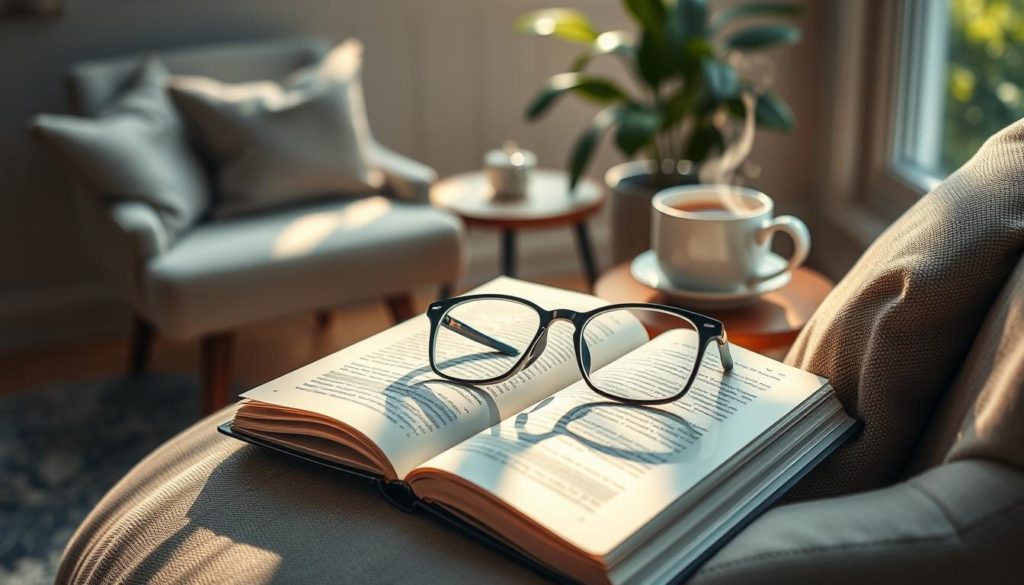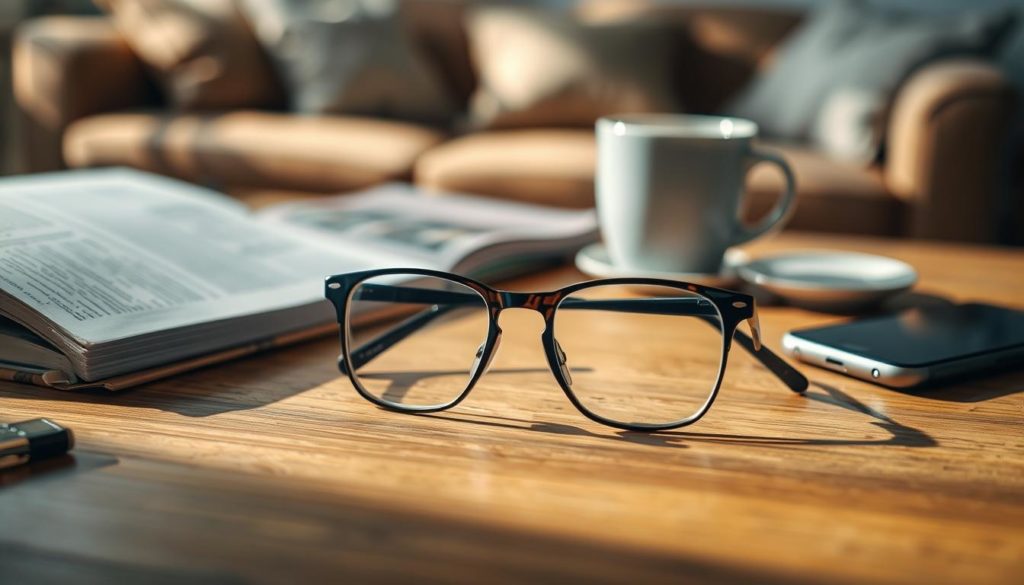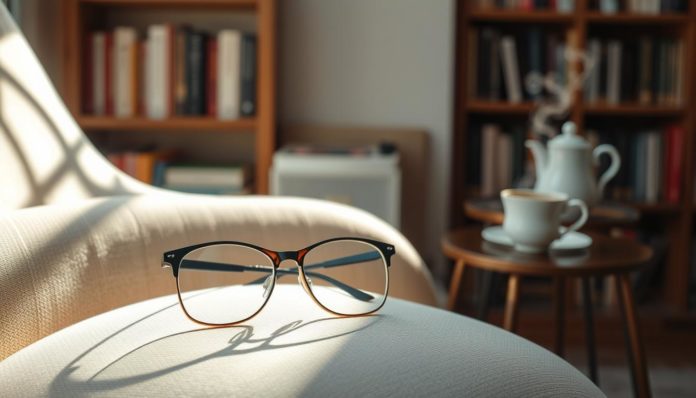Did you know that over 150 million Americans need glasses? With more screen time, bifocals and progressive lenses are getting popular. But, switching to them can be tough.
Getting used to bifocals and progressives can be easier with the right tips. This article will share helpful advice for a smooth transition. Remember, adapting takes time and patience for clear vision.
Understanding the Basics of Bifocals and Progressive Lenses
Bifocals and progressive lenses are great for people with multiple vision problems. Bifocals are good for presbyopia, while progressive lenses are newer and more natural. Knowing the difference helps you choose the right one.

Bifocal lenses have two parts: one for distance and one for near vision. They’re great for those who need clear vision for different tasks. Progressive lenses, however, have a smooth transition without lines. They look better and feel more natural.
Let’s explore more about these lenses:
| Lens Type | Design | Benefits |
|---|---|---|
| Bifocal Lenses | Two segments for distance and near vision |
|
| Progressive Lenses | Gradual transition between multiple focal points |
|
Your eye doctor will pick the right lenses for you. They consider your lifestyle and daily tasks. Bifocals might work for some, but progressive lenses are often better for everyone.
Adapting to progressive lenses takes some time. Your brain gets used to seeing clearly at different distances.
Choosing the right lenses is key to comfort. Good bifocal and progressive lenses make daily tasks easier. They improve your life quality.
In short, knowing the differences between bifocal and progressive lenses helps you choose wisely. This ensures your vision needs are met well and comfortably.
Common Challenges When Adjusting to Bifocals and Progressives
Starting with new bifocals or progressive lenses can be tough at first. Here are some common issues people face while coping with bifocal glasses:
- Dizziness: Feeling dizzy or nauseous is common when first wearing bifocals. This feeling usually goes away in a few days as your brain gets used to seeing things differently.
- Depth Perception: Many people struggle with depth perception when they first start wearing bifocals. This makes things like walking stairs or driving hard. But don’t worry, with practice, your eyes will get better at judging distances.
- Peripheral Vision: Bifocals and progressives can make things blurry or stretched at the edges. Try moving your head instead of your eyes to help with this.

These challenges are all part of getting used to eye wear adjustments for bifocals. Remember, being patient is key. With time, your vision will get better, and these problems will lessen. If you’re still having trouble, it’s a good idea to talk to your optometrist. They can check if your prescription and fit are right.
Initial Steps for a Smooth Transition
Starting with bifocal and progressive lenses might feel tough at first. But, taking a few steps can make it easier. By using smart approaches, you can get used to your new glasses quickly and comfortably.
Wearing Your New Glasses
Wear your new bifocals or progressive lenses every day from the start. This helps your brain get used to the new zones. Make sure your glasses fit right on your nose for the best results.
Gradual Increase in Wearing Time
It’s also key to wear them more each day slowly. Start with an hour or two and then wear them all day. This way, you avoid discomfort and let your eyes adjust slowly.
Practicing at Home
Doing activities at home, like watching TV and reading, helps a lot. Practicing in a place you know makes adjusting easier. Also, doing tasks like going up and down stairs helps you get used to them.
Importance of Choosing the Right Frame
Choosing the right frame is key when you get new bifocals or progressives. It’s all about comfort and style. This guide will show you how to pick a frame that fits well and suits your lifestyle.
Frame Size and Shape
The size and shape of your frame affect how you see with your progressive lenses. Bigger frames give more room for different lens parts, making it easier to switch between them. But, they must also match your face shape to avoid slipping or feeling uncomfortable.
Frames should sit comfortably on your temples and be wide enough not to dig into your head.
Material and Weight Considerations
The material of your frames is important for both lasting quality and comfort. Light materials like titanium or acetate reduce pressure on your nose and ears, making them more comfortable to wear for a long time. Also, choosing hypoallergenic materials can prevent skin irritation.
As the progressive lens fitting guide suggests, the right mix of frame material and weight makes for a more enjoyable and adjustable wear.
Getting the Correct Prescription and Fit
Having the right prescription and fit is key for comfort and clear vision with bifocals or progressives. An accurate prescription is the base for successful adaptation. So, it’s important to get your eyes checked often by an eye care professional. Tell them about any vision problems you have for precise adjustments.
Working with an eye care professional is crucial. It helps get an accurate prescription and ensures the lenses fit right in your frames. The fit depends on several measurements that need a pro’s touch, like the distance between your pupils and the lens height on your nose.
- Measurement of Pupillary Distance: This ensures the optical center of the lenses aligns with your eyes.
- Lens Height: The placement of the bifocal line or progressive lens segment is accurate, helping with vision correction.
Here’s a detailed look at critical measurements:
| Measurement | Purpose | Benefits |
|---|---|---|
| Pupillary Distance (PD) | Aligns optical centers of lenses | Reduces strain and enhances vision |
| Lens Height | Positions bifocal/progressive segments accurately | Improves adaptation and comfort |
| Frame Fit | Ensures stability and comfort | Minimizes slippage and maximizes precision |
Getting used to progressive lenses takes time. If you face any issues, go back to your eye care professional. They can make adjustments for better vision and comfort. Regular check-ups keep your prescription current and your lenses fitting well.
Adjusting the Way You Look Through the Lenses
Progressive lenses and bifocals need a new way to look through your glasses. This is to get the best vision at different distances. Here are some Progressive lens acclimation tips and bifocal usage techniques to help you adjust quickly and comfortably.
Using the Top Section for Distance
For distant objects, use the top section of your lenses. It’s made for seeing far away clearly. Tilt your head slightly down and look through the upper part for a sharp view of the horizon or distant scenery.
Employing the Bottom Section for Reading
For reading or close-up tasks, look down to the bottom section of the lenses. Bring reading materials close and look through the lower half for sharp vision. Getting used to this bifocal usage technique can greatly improve your reading experience.
Using the Middle Section for Intermediate Distances
The middle section is for intermediate distances, great for computer work or cooking. Look straight ahead to smoothly switch between near and far distances. This Progressive lens acclimation tip ensures clear vision for all your daily activities.
Tips for Reducing Eye Strain and Discomfort
Getting used to bifocal and progressive lenses can be tough. But, there are ways to make it easier. Follow these tips to feel more comfortable.
Proper Lighting
Good lighting is key when you’re wearing these lenses. Bright, even light stops you from squinting and eases eye strain. Place your light source behind you or over your shoulder. This way, light won’t bounce off your lenses.
Taking Regular Breaks
Too much screen time or reading can make your eyes uncomfortable. Try the 20-20-20 rule. Every 20 minutes, look at something 20 feet away for 20 seconds. This simple trick can really help.
Exercises for Eye Relaxation
Adding eye exercises to your day can make a big difference. Blink often, roll your eyes, and look at distant objects. These actions can keep your eyes feeling fresh and relaxed.
How to Clean and Maintain Your Bifocals and Progressives
For those who rely on bifocals or progressives, keeping lenses clear and long-lasting is key. Here’s some practical advice and tips to keep your vision sharp and your glasses in good shape.
Cleaning Technique
To keep your vision clear, cleaning your lenses right is crucial. Start by rinsing your glasses under warm water to get rid of dust. Use a mild, soap-free dish soap to clean both sides of the lenses. Rinse well and dry with a clean, lint-free cloth to prevent scratches.
Don’t use paper towels, tissues, or your shirt’s edge to clean your glasses. These can scratch the lenses. Regular cleaning stops dirt and oils from building up, keeping your vision clear.
Storage Tips to Avoid Damage
Storing your glasses right is also key. Always put them in a hard-shell case when not wearing. This keeps them safe from drops and scratches.
Don’t put your glasses lens-side down on surfaces. Instead, store them in their case or on a soft, clean spot to avoid damage.
Use the following table to summarize the key points:
| Cleaning Technique | Storage Tips |
|---|---|
| Rinse with lukewarm water | Store in a hard-shell case |
| Use mild dish soap | Avoid lens-side down placement |
| Dry with a lint-free cloth | Place on a soft, clean surface |
By following these tips and maintaining your glasses regularly, you can keep them in great shape. This ensures clear vision and longer use of your eyewear.
Consulting Your Eye Care Professional
Regular eye care professional consultation is key when switching to bifocals or progressives. These meetings help make sure your prescription fits you perfectly.
Your eye doctor will check your vision and tweak your prescription as needed. These visits can fix any discomfort or problems, making it easier to get used to your new glasses.
An eye care professional consultation is also a chance to talk about any issues. If you’re having headaches or blurry vision, seeing your eye doctor is crucial. They can help quickly.
Key Benefits of Regular Consultations:
- Personalized bifocal prescription adjustment
- Professional guidance on lens adaptation
- Monitoring and addressing potential eye strain
- Optimizing lens fit for comfort and clarity
| Aspect | Benefit |
|---|---|
| Customized Prescription | Ensures optimal vision and comfort |
| Professional Guidance | Smoother transition to new lenses |
| Symptom Monitoring | Early detection and resolution of issues |
Remember, regular eye care professional consultation and quick bifocal prescription adjustment are vital. They help you enjoy your new glasses without any hassle.
Dealing with Symptoms: When to Seek Help
Getting used to bifocals or progressive lenses can be tough. But knowing when to get help is key. This ensures your eyes stay healthy and your vision clear.
Persistent Headaches
Mild headaches are normal when starting with new glasses. But if they last more than a week, it’s time to check your glasses. Headaches can mean your eyes are strained, and you might need professional help.
Consistent Blurriness
Some blurriness is okay at first. But it should get better as you get used to your glasses. If it doesn’t, make sure your lenses are clean and on right. If it still doesn’t get better, your optometrist might need to adjust your lenses.
Uncomfortable Vision Distortion
Distortion with progressive lenses is common but should not be constant. If you see wavy or distorted vision that doesn’t go away, your lenses might be off. Getting this fixed quickly is important for your vision.
If these symptoms bother you a lot, see your eye doctor. They can help you adjust smoothly to your new glasses. This protects your vision and overall health.
FAQ
How long does it take to get used to bifocals or progressive lenses?
It takes a few days to a couple of weeks for most people. Just be patient and wear them every day.
What are the main differences between bifocal and progressive lenses?
Bifocals have clear sections for near and far vision, with a line in between. Progressive lenses blend these sections smoothly, without a line.
Why do I feel dizzy or nauseous when wearing my new bifocals?
These feelings are normal when you first start wearing them. Your eyes and brain are adjusting.
How can I make the transition to bifocals or progressives smoother?
Wear your glasses often, start with short periods, and practice at home. This helps your eyes adjust.
How do I choose the right frame for my bifocals or progressive lenses?
Pick frames that fit your face well and are lightweight. This makes them more comfortable, especially for progressive lenses.
How important is it to get the correct prescription and fit for my lenses?
It’s very important! A correct prescription and fit from an eye care professional ensure the best vision correction.
What is the best way to look through the different parts of my progressive lenses?
Use the top for distance, the middle for computer work, and the bottom for reading.
How can I reduce eye strain and discomfort with my new lenses?
Make sure the room is well-lit, take breaks from close work, and try eye exercises to relax your eyes.
What is the best way to clean and maintain my bifocals or progressives?
Clean with a microfiber cloth and lens cleaner. Store them in a hard case to avoid scratches.
How often should I consult my eye care professional when adapting to new lenses?
Visit regularly, especially if you’re feeling uncomfortable. Your eye care professional can adjust your prescription or fit if needed.
When should I seek help for symptoms like headaches or vision distortion?
If you have headaches, blurriness, or uncomfortable vision, see your eye care professional. They can check your prescription and fit.


